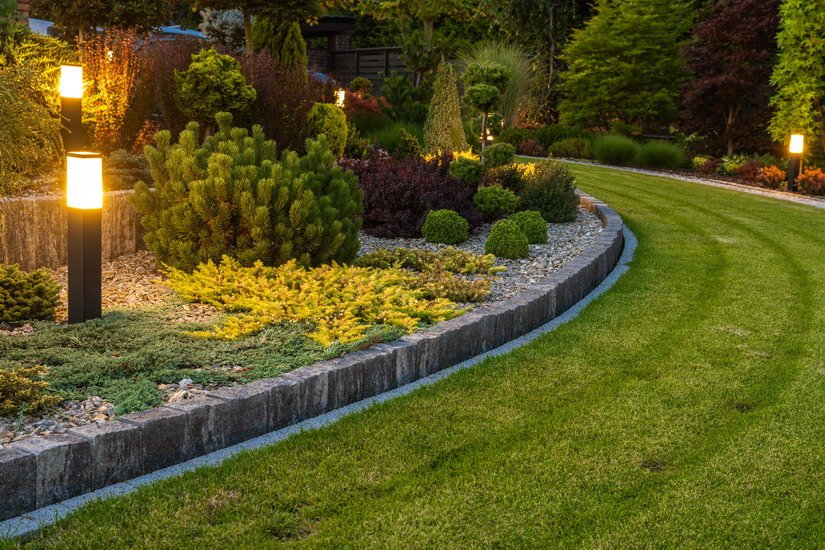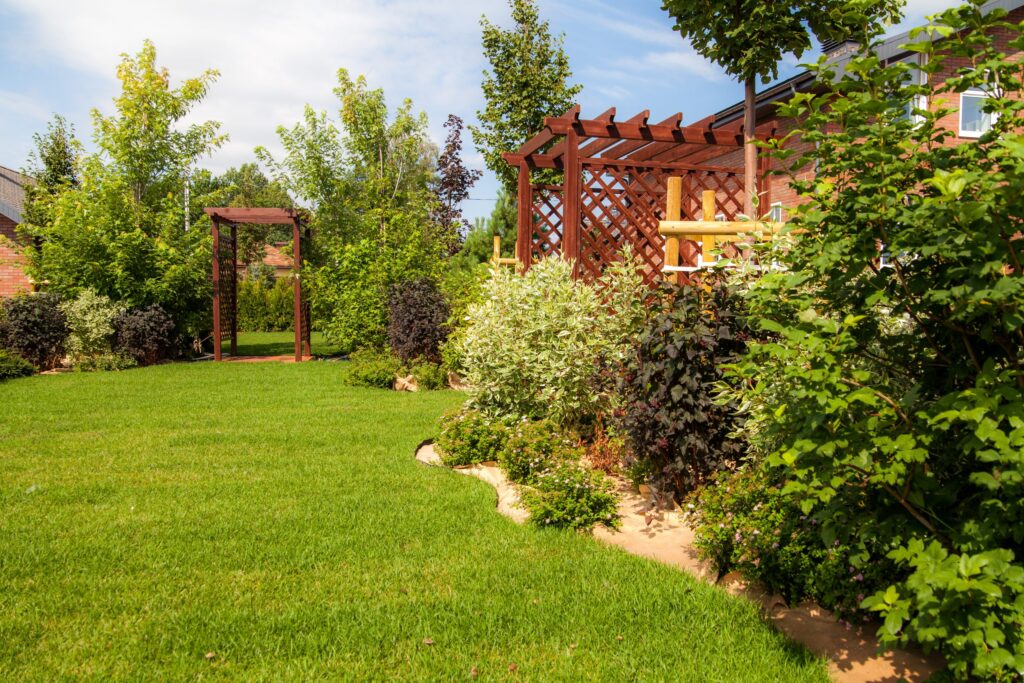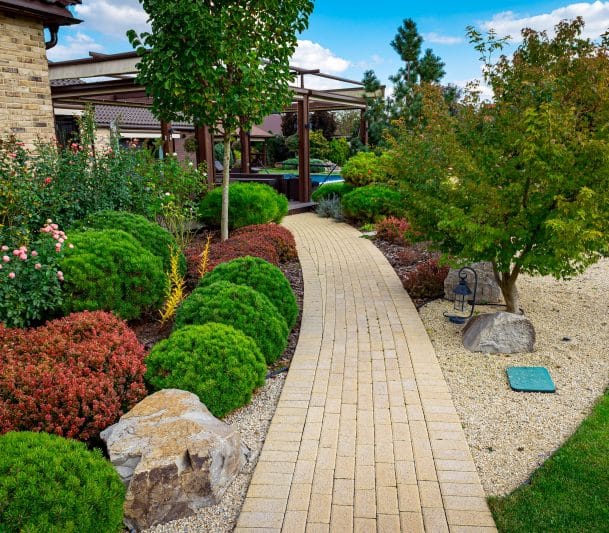Understanding the Comprehensive Range of Functions in Professional Landscape Design Services
The substantial range of expert landscape design services incorporates a range of fundamental components - landscaping. It consists of landscape layout concepts, plant selection, and hardscaping features. Additionally, it deals with irrigation systems and upkeep techniques. Each element plays a critical duty in creating practical and cosmetically pleasing outdoor rooms. Understanding how these elements work with each other can reveal much concerning the art and scientific research of landscape design. Nonetheless, the trip into this detailed area is simply beginning
Landscape Design Principles
Reliable landscape design concepts are crucial for developing unified outside spaces that enhance both aesthetic charm and functionality (Learn More). These concepts guide the arrangement of aspects within the landscape, ensuring a cohesive aesthetic experience. Secret components consist of equilibrium, which disperses aesthetic weight uniformly; proportion, which associates the size of numerous aspects to each various other and the space; and unity, which develops a sense of integrity through regular motifs and materials

Plant Choice and Setup
In the domain of specialist landscaping, plant choice and installment play a crucial function in attaining a thriving yard. Stressing indigenous plant benefits, seasonal factors to consider, and the specific dirt and sunlight needs of each varieties assures a sustainable and aesthetically pleasing landscape. Careful planning in these locations not just boosts biodiversity yet likewise advertises long-term ecological health and wellness.
Native Plant Benefits
Why should property owners consider native plants for their landscape design projects? Native plants use numerous advantages that enhance both looks and environmental sustainability. They are well-adapted to local environments, requiring less water and upkeep compared to non-native varieties. This resilience reduces the demand for chemical plant foods and pesticides, advertising a much healthier ecological community. Additionally, indigenous plants supply habitat and food for neighborhood wild animals, including pollinators, which can raise biodiversity in houses. Their knowledge with neighborhood dirt and weather condition problems also brings about better growth prices and longevity. By selecting native plants, house owners not just produce visually appealing landscapes but likewise add to eco-friendly preservation, making a positive influence on their local atmosphere. Indigenous plants represent a smart option for landscape design projects.
Seasonal Plant Considerations
Homeowners who have accepted native plants in their landscape design can better improve their outdoor rooms by taking into consideration seasonal plant options. By integrating plants that flourish in certain seasons, they can create visually attractive and dynamic landscapes throughout the year. Spring might introduce dynamic flowers like tulips and daffodils, while summer season can showcase lush foliage and colorful perennials. Autumn presents a combination of warm tones with asters and goldenrods, while winter months can be highlighted with evergreens and ornamental lawns for texture. Specialist landscapers often recommend selecting plants that not just complement existing indigenous varieties but additionally offer year-round interest and support local wildlife. This thoughtful approach to seasonal plant choice assures a consistently progressing and lasting yard setting.
Soil and Sunshine Needs
Effective landscape design rests on comprehending the certain dirt and sunshine demands of plants. Different species prosper under varying problems, requiring a mindful assessment of both aspects throughout the selection process. Dirt kinds, such as sandy, clay, or fertile, impact water drainage, nutrient accessibility, and origin development. Additionally, pH degrees can affect plant health and wellness, necessitating dirt screening to determine viability. Sunshine requirements vary significantly; some plants grow completely sun, while others prefer partial or complete shade. An expert landscaper considers these elements to ensure peak growth and aesthetic allure. By aligning plant selections with the setting's specific qualities, landscapes can achieve sustainability, durability, and aesthetic harmony, inevitably leading to effective plant establishment and lasting upkeep.
Hardscaping Functions and Construction

While landscaping typically evokes photos of lush greenery and vivid blossoms, hardscaping functions play a vital function in specifying outdoor spaces. These components, which consist of patios, pathways, retaining wall surfaces, and attractive stonework, offer framework and functionality to backyards and yards. Hardscaping utilizes products such as concrete, rock, timber, and brick, enabling varied styles that complement the all-natural landscape.
The building and construction of hardscaping attributes needs mindful planning and implementation to guarantee durability and visual appeal. Professionals evaluate site conditions, drainage, and spatial relationships to develop natural outside atmospheres. Correct setup strategies are important, as they protect against problems like disintegration and shifting gradually.
Including hardscaping not only boosts the aesthetic interest of a property but additionally assists in exterior activities, making it an essential facet of thorough landscape design services. Ultimately, thoughtful hardscaping adds to both the functionality and beauty of exterior rooms.
Watering Systems and Water Administration
Efficient watering systems and water management are important parts of professional landscape design, as they ensure that plants obtain the needed hydration for excellent development. These systems can differ from simple drip watering arrangements to innovative automated lawn sprinkler, created to meet the details requirements of varied landscapes. Correct water management not only enhances water use, decreasing waste, however also improves plant health and reduces disease risks.
Landscaping professionals examine various variables, including soil kind, plant species, and local climate, to develop tailored irrigation solutions. Additionally, including rainwater harvesting techniques can additionally improve sustainability and effectiveness. Normal upkeep of watering systems is crucial to maintain capability and protect against leaks, which can cause water loss and boosted costs (Learn More). Inevitably, a well-designed irrigation system plays an essential function in preserving the visual charm of exterior areas while advertising ecological stewardship within professional landscaping practices
Yard Care and Maintenance Approaches
Grass treatment and upkeep approaches are fundamental for attaining a lavish, healthy lawn that boosts the overall landscape. These techniques include different practices read more focused on advertising suitable growth and aesthetic charm. Regular mowing is crucial, as it motivates thick, even growth while stopping weeds from establishing. In addition, appropriate fertilization supplies needed nutrients, with applications tailored to the certain turf kind and soil problems.
Watering practices need to concentrate on deep, seldom watering to encourage origin growth, while aeration enhances dirt framework and advertises nutrition absorption. Bug and condition management is also essential; identifying concerns early enables reliable therapies that reduce damages.
Overseeding can invigorate damaged or slim yards, improving density and shade (landscaping). By applying these targeted lawn treatment approaches, landscape design specialists can guarantee that lawns continue to be dynamic and healthy and balanced throughout the periods, significantly adding to the general appeal of the residential property
Seasonal Landscape Care and Upkeep
As the seasons change, proper landscape care comes to be vital for keeping the health and elegance of outdoor rooms. Each season offers one-of-a-kind difficulties and needs. In springtime, landscape specialists concentrate on pruning, growing, and feeding to urge growth. Summer season needs regular watering, weed control, and insect monitoring to safeguard newly developed plants.

Throughout the year, seasonal landscape upkeep assurances that outdoor areas continue to be visually attractive and healthy. Professional services can supply customized upkeep plans that adjust to the particular demands of each period, allowing homeowner to enjoy dynamic landscapes year-round. In general, seasonal care is a crucial facet of expert landscape design that advertises long life and visual worth.

Lasting Landscaping Practices
A growing variety of homeowner are welcoming sustainable landscaping methods to develop eco-friendly outside rooms. These practices focus on preserving resources, improving biodiversity, and decreasing ecological influence. Native plants are commonly selected for their reduced water demands and compatibility with regional ecological communities, reducing the requirement for chemical plant foods and chemicals. Rainfall gardens and permeable paving are employed to manage stormwater overflow, advertising groundwater recharge and reducing disintegration.
Additionally, sustainable landscaping incorporates natural gardening strategies that focus on soil health and wellness and advertise natural pest control. Reliable irrigation systems, such as drip watering and rainwater harvesting, help optimize water use. In addition, landscape designers progressively promote for making use of recycled products, such as recovered timber and stones, to reduce waste. By embracing these sustainable methods, home owners not only contribute to eco-friendly preservation however also create aesthetically pleasing settings that can love minimal maintenance.
Regularly Asked Inquiries
The length of time Does a Landscape Design Project Normally Require To Full?
Normally, a landscaping task can take anywhere from a few days to numerous weeks to finish, depending upon the project's dimension, intricacy, and layout requirements. Aspects such as weather and source accessibility likewise affect timelines.
What Variables Influence the Cost of Landscape Design Services?
Numerous elements influence landscape design solution expenses, including project size, layout intricacy, material quality, labor expenditures, geographic area, and seasonal need. Each component adds uniquely to the general economic demands of a landscaping job.
Are Landscape Design Provider Available Year-Round?
Landscaping services are usually available year-round, although schedule might differ based on region, seasonal weather condition conditions, and certain service offerings. Some services may be limited throughout severe weather condition or off-peak periods.
Do Landscaping Firms Offer Warranties on Their Work?
Numerous landscape design firms do provide guarantees on their job, which can differ in size and coverage. Clients are motivated to inquire concerning details terms, guaranteeing they understand what is guaranteed and any problems that use.
Can I Design My Landscape Without Specialist Aid?
Yes, people can create their landscapes without professional help. They might do not have knowledge in plant choice, format, and environmental factors to consider, potentially leading to less efficient styles that can call for expensive modifications later on.
In the domain of expert landscape design, plant selection and setup play a vital function in accomplishing a flourishing garden. House owners who have accepted native plants in their landscape design can better boost their exterior rooms by considering seasonal plant choices. Successful landscaping pivots on recognizing the specific dirt and sunshine requirements of plants. Efficient watering systems and water administration are crucial components of professional landscaping, as they guarantee that plants obtain the necessary hydration for ideal development. Landscape design professionals analyze different elements, consisting of dirt type, plant varieties, and regional environment, to establish customized irrigation services.